Unsure about your French table manners? Click Here to download > > How to avoid these 10 food etiquette mistakes !
- Home ›
- Destinations ›
- Normandy ›
- Rouen's Culinary Secrets
4 Culinary Pleasures You Must Not Miss in Rouen, France
Published 6 April 2024 by Leyla Alyanak — Parisian by birth, Lyonnaise by adoption, historian by passion
Normandy already has a fabulous gastronomic reputation, and Rouen, its capital, is the only French city to be listed in the gastronomic category of UNESCO's Creative Cities Network. But its prestige was made long before...
The date was 3 November 1948 and (soon to be beloved chef) Julia Child had just stepped off the boat to France.
The very first lunch she had would help change her life. She called it "...absolute perfection. It was the most exciting meal of my life.”
That lunch took place in Rouen, at La Couronne, and for her to find it so extraordinary was merely confirmation of Normandy's culinary excellence. The region's fresh produce, rainfall and diversity have transformed it into a destination for food lovers of every stripe.
Rouen is the kind of city in which you can pop into a restaurant, almost any restaurant, and be pleased with the result. It's just that full of excellent food. But apart from its splendid eateries, Rouen has a lot to offer the culinary enthusiast.
Here are four you shouldn’t miss.
NOTE: Pages on this site may contain affiliate links, which support this site. See full Privacy Policy here.
1. A not-so-ugly duckling
If Rouen is famous for a single dish, it is the “Canard à la Rouennaise” (also known as Canneton Rouennais, or Rouen duck or duckling). Simply put, it’s a duckling – the species is a cross between domestic and wild duck – prepared in its own blood.
While the recipe is relatively simple, the preparation itself is complex. The duck is first cooked and cut up in the kitchen, but then the action moves to the dining room where the pieces are flambéed and placed in a special press, the blood extracted and used to bind the sauce. The pressing takes place at your table and is an event visitors reserve well ahead of time.
Not just anyone can prepare this duck. In fact, there’s a special fraternity, the Ordre des Canardiers, or Duck Masters, whose job it is to make sure tradition is perpetuated, and the recipe respected.
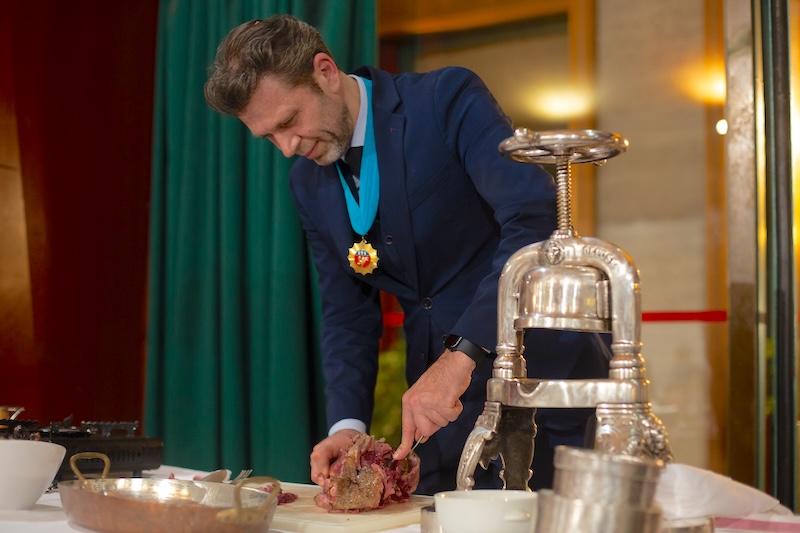 Here, the renowned Canard à la Rouennaise is being prepared at the Café Viktor, in the Hotel de Dieppe, by a Maître Canardier (note the Order's ribbon)
Here, the renowned Canard à la Rouennaise is being prepared at the Café Viktor, in the Hotel de Dieppe, by a Maître Canardier (note the Order's ribbon)The Order was created by a certain Michel Guéret, who was the owner and chef of the Hotel de Dieppe (home of the Viktor Café), where the recipe that is still used today first took shape.
My only criticism is that I was unable to taste this dish during my visit, a clear indication I'll have to return.
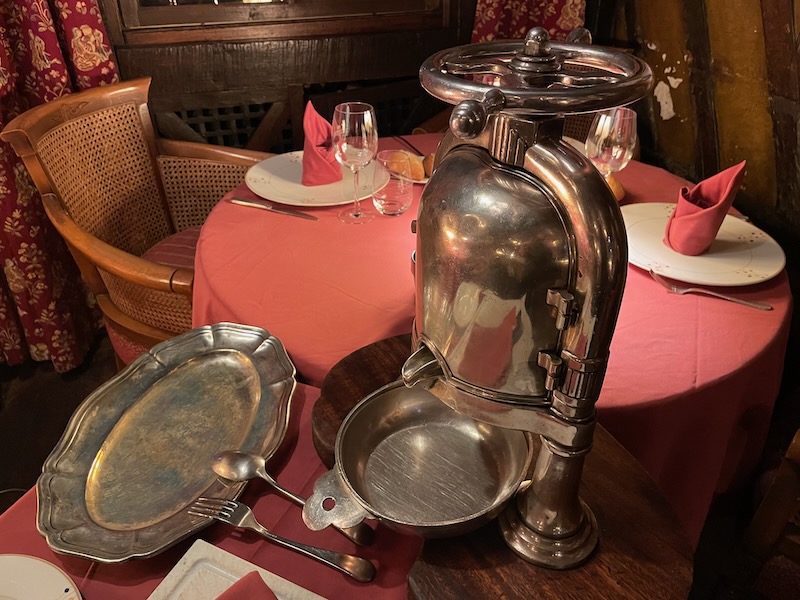 This is a press used to press the duck at your table. I took this photo at La Couronne restaurant on the Place du Vieux-Marché, which also serves this dish (©OffbeatFrance/Leyla Alyanak)
This is a press used to press the duck at your table. I took this photo at La Couronne restaurant on the Place du Vieux-Marché, which also serves this dish (©OffbeatFrance/Leyla Alyanak)2. Camembert and friends
Normandy’s dairy industry hardly needs introduction, its creams and butters much-loved throughout France.
But how well do you know its cheeses?
Normandy has four AOP cheeses, and you can often tell them apart by their appearance if they’re whole (if they appear on your plate already cut, just ask the server):
- Camembert: this one you know, a round cheese with a textured whitish-yellow rind
- Pont l’Evêque: it’s the only one of the four that is square-shaped
- Livarot: it is round, with a patterned orange rind, and is layered on the side with reeds
- Neufchâtel: the easiest to spot, shaped like a heart
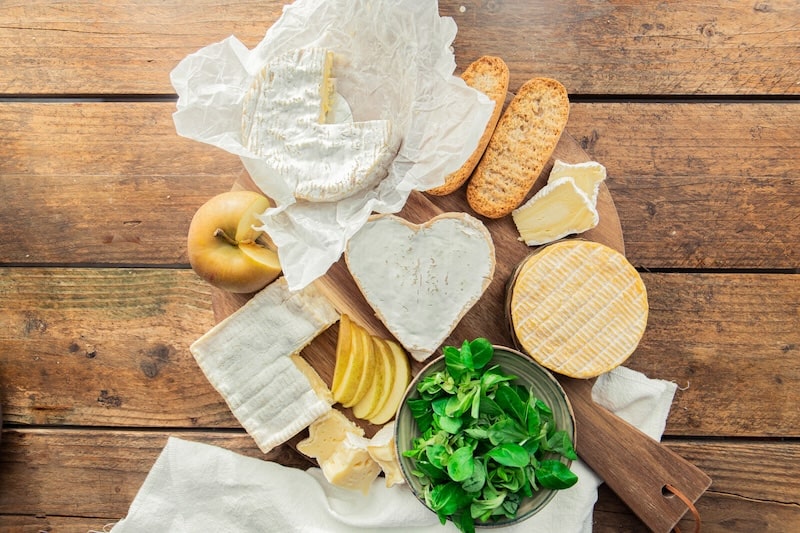 A cheese platter with Normandy's four AOP cheeses. Top left is the Camembert; at 3 o'clock is the Livarot; bottom left is the Pont l’Evêque; and in the center, the heart-shaped Neufchâtel (©Mathilde Boclet)
A cheese platter with Normandy's four AOP cheeses. Top left is the Camembert; at 3 o'clock is the Livarot; bottom left is the Pont l’Evêque; and in the center, the heart-shaped Neufchâtel (©Mathilde Boclet)WHAT ARE AOP CHEESES?
AOP means Appellation d’Origine Protégée, or Protected Designation of Origin. In other words, the label is evidence that a product (cheese, wine and other products) was produced with specific regional knowledge so that all will have the same characteristics and be certified as authentic.
I never came across a restaurant that didn’t serve these cheeses during my stay, so you should have no trouble sampling them when you eat out.
If you’d rather have a picnic, grab a baguette in one of the city’s top boulangeries (Ma Boulangerie is a great one). Then make a beeline for the Maison Jollit (here’s their Facebook page), Ma Fromagerie, or the Fromagerie du Vieux-Marché and stock up. All these are in the heart of the Old Town.
If you’re super keen on cheese and have a car, consider a drive along Normandy’s Route du Fromage, the Cheese Trail. It’s not a formal trail but this map will give you an idea of where you can stop – and where to buy.
3. Vive la pomme!
Here in my little patch of Eastern France, a man with a van drives through every few months selling organic potatoes, onions, carrots, and… apples!
He’s from Normandy, where France’s best apples come from, and while I have my own apple trees, I somehow end up with extra bags of apples I can transform into delicious Norman recipes (that usually involve pies and cream).
It’s impossible to list all their varieties – they run in the hundreds (and there may have once been as many as 4000).
They have different uses: the ones we eat are considered “pommes à couteau”, or apples that you cut, and then...
There are apples for drink.
You’ve probably heard of Normandy’s cider, made from smaller, sour apples loaded with tannin. These are first made into juice, whose sugars will become alcohol, each differing in taste depending on the farm. It has about 3°-5° alcohol content, is thirst-quenching, and is a favorite accompaniment for lunch or a snack, or even dinner. Anytime, really.
The stronger alcohol is apple brandy, or Calvados, an eau-de-vie which is served at the end of a meal, to aid digestion. It isn’t stored in bottles, like wine, because it would stop ageing. Instead, it is stored in oak casks, which allows sediment to float down until the Calvados is distilled and finally bottled.
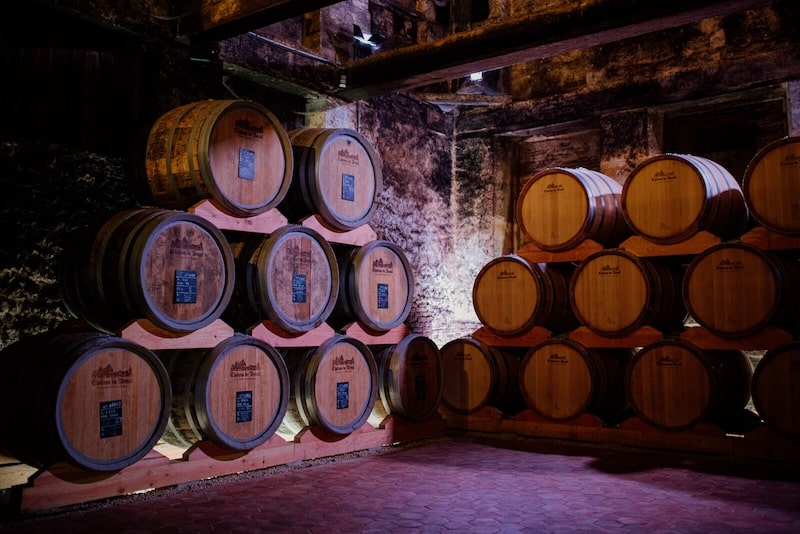 Oak barrels filled with Calvados at the Château du Breuil, Pays d'Auge (©Marie-Anaïs Thierry)
Oak barrels filled with Calvados at the Château du Breuil, Pays d'Auge (©Marie-Anaïs Thierry)And then there’s a mix: pommeau, which is a marriage between cider apples and calvados, is something you have as an aperitif, a favorite French pastime. Pommeau is an ancient drink, and is served chilled, a bit like sherry (looks like it too).
To sample the apples (and derivatives), you can follow one of the many routes or trails Normandy is so good at setting up: the Cider Route, the Fruit Trail (site in French)... Even if you don't have a car, you can cycle to some of these.
4. Lunch like Julia Child at La Couronne, Rouen
La Couronne is famous for quite a few things, and proudly so.
First, its heritage. It is considered the oldest inn in France, its tax payments documented as early as 1345 on a piece of parchment by the then owner, Raoul Leprevost.
Second, celebrities have eaten here, too many to count. Julia Child, of course, but not only.
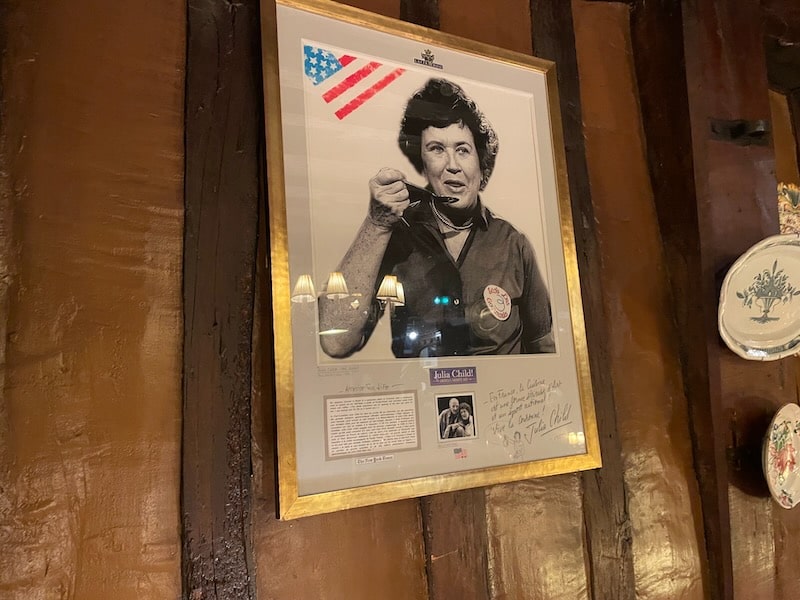 Photo of Julia Child on the wall of La Couronne in Rouen (©OffbeatFrance/Leyla Alyanak)
Photo of Julia Child on the wall of La Couronne in Rouen (©OffbeatFrance/Leyla Alyanak)Walking along the photo-filled hallways, I spotted dozens of autographs from the glitterati who had dined here, people like John Wayne and Brigitte Bardot and Sophia Loren.
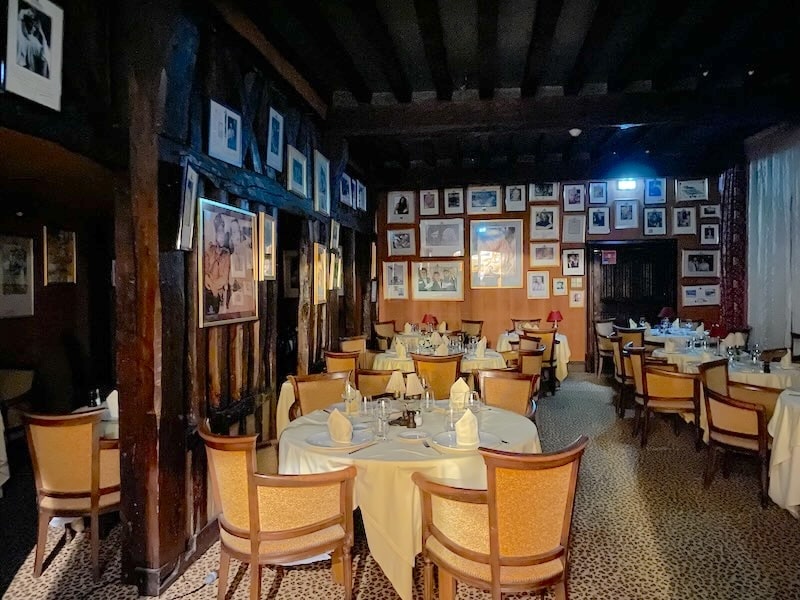 Upstairs floor at La Couronne, its walls papered with celebrity photos (©OffbeatFrance/Leyla Alyanak)
Upstairs floor at La Couronne, its walls papered with celebrity photos (©OffbeatFrance/Leyla Alyanak)Third, the food. Yes, the real reason one comes to a restaurant.
I didn’t have the Julia Child menu of sole meunière (for two people) but I did have the Impressionist Menu. I’m not sure why it is called this and I forgot to ask, but here might be a clue: I ordered the risotto with walnut emulsion and parsley. Rather than a bowl of velvety rice, I was delivered several perfectly round, deep-fried rice kromeski, or croquettes, a bit like Sicilian arancini. It was not actually a risotto, but a delicious impression of risotto.
And fourth, the location. La Couronne is on the Place du Vieux-Marché in the heart of Rouen, and even if you don’t eat here, you’re bound to walk past it once or twice.
This square is where, on Wednesday, 30 May 1431, Joan of Arc was driven in a cart to the wooden stake set up a stone’s throw from La Couronne. According to popular lore, the inn was full that night. As Joan's life left her, those with the means had a front-row seat to see the hatred played out.
Certainly macabre, but remember, public executions were once considered entertainment. Thankfully we have others today.
Bonus: La Fête du Ventre
This one is time-sensitive and is held in October, so if this is when you're planning your trip... try to include the Fête du Ventre!
While in French the name “Festival of the Stomach”, or “Belly Festival”, evokes fullness and satiety, it doesn’t translate that well into English… never mind, we’re going there to eat, not to learn grammar.
The Fête du Ventre has been around for a quarter of a century, the revival of an event that was popular in the 1930s.
This festival confirms Rouen’s place as a culinary must-visit: each year, some 160 producers converge around the center of town, within sight of the Church of Joan of Arc and the Old Market Square. Not just any stalls, but the best of the best, with spreads that include Normandy’s famous cheeses, natural produce, or renowned seafood.
If you're a foodie, this is one festival to keep an eye on.
Before you go…
To spread your French culinary wings, you can read all about France’s favorite foods, but also, perhaps, these weird or unusual French dishes you may have come across in your travels.
After all, food is an intrinsic part of France’s heritage, and every destination prides itself on contributing to that heritage. All we have to do is show up and sample.
IF YOU NEED TO RENT A CAR IN FRANCE
Don't wait until the last minute, especially if you want one of the scarcer automatics.
🚗 Check availability at Discover Cars (it's what I use to compare prices).
Did you enjoy this article? I'd love if you shared it!

